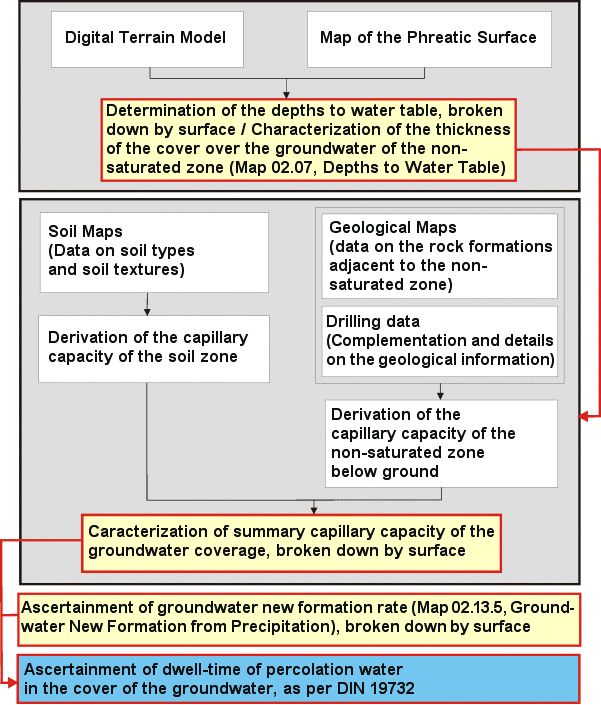In the map, the dwell time of the percolation water in the non-saturated zone is represented as a measure for the intrinsic pollution sensitivity of the groundwater. The certification of specific pollution sensitivity requires the consideration of concrete pollutants, pollutant quantities and uses, which is more significant for concrete and detailed location investigations than for extensive representations.
The mean dwell times of the percolation water in the non-saturated zone – i.e. the period which the percolation water requires to move from the surface to the groundwater table under the force of gravity – were calculated. A method which allows the estimate of this dwell time on the basis of available climatic hydrologic and geological pedological data was developed at the Brandenburg Technical University of Cottbus (BTU method) (Heinkele et al. 2000, Voigt et al. 2003). The calculation of the percolation water speed and the dwell time of the percolation water in the non-saturated zone are carried out by reference to DIN 19732 "Determination of the Site-Shift Potential of Non-Absorbable Substances." This procedure as per DIN 19732 was originally designed for the assessment of local locations, but with modification (see below), it is also suitable for larger-scale observations.
The following parameters affect the determination of the dwell time of percolation water in the groundwater overburden:
new groundwater formation
capillary capacity of the groundwater overburden
thickness of the groundwater overburden.
New groundwater formation is derived from the percolation water rate and represents the water quantity which arrives at the groundwater table and replenishes the groundwater stocks (see Map 02.13.5).
Capillary capacity means the quantity of water which is adsorbed in the non-saturated soil zone due to cohesion and capillary forces and can be retained against the force of gravity (i.e., it does not percolate immediately). This is primarily water in pore-centered radii < 50 µm. This water quantity can be described as soil moisture in per cent by volume of the soil. This capillary capacity is dependent on soil type. The assignment of capillary capacities to soil types is carried out according to the geological mapping guideline Ka 4 (Soil Ad-Hoc Working Group 1994). Fine-grained soils have a high capillary capacity (e.g. clay between 40 % and 54 %), while coarse-grained soils have low capillary capacity (e.g., coarse to medium-grain sand between < 10 % and 13 %). A large quantity can therefore be adsorbed into percolation water and stored in fine-grained soils. A shift of percolation water due to gravity occurs only at water contents above capillary capacity.
The capillary capacity of the groundwater overburden is the water that can be adsorbed and retained in the entire non-saturated zone in this manner. It can be determined expansively from the data on the distribution of types of soil and rocks in soil maps, geological maps and the results of drillings, with consideration for the thickness of the groundwater overburden.
The thickness of the groundwater overburden corresponds to the depth to groundwater and is immediately derivable from the appropriate maps, with consideration for the unusual features of unconfined and confined groundwater conditions. The thickness of the groundwater overburden has been taken from Map 02.07 Depth to Groundwater of the Environmental Atlas, and refers in each case to the nearest-to-surface aquifer (GWL) which permanently carries water. In most cases, this is the main aquifer (GWL 2, according to the categorization of Limberg and Thierbach 2002), which is used for the drinking-water supply of Berlin, and is open in the glacial spillway, but covered in the area of the plateaus. In some areas, the evaluation was carried out on the basis of the GWL 1 (e.g. in the area of the Panke Valley) or the GWL 4 (tertiary formations).
The dwell time ts of the percolation water in the groundwater overburden, i.e., the time period during which the water moves from the surface to the groundwater can be derived from the new groundwater formation, and from the thickness and the capillary capacity of the groundwater overburden, according to the following equation (Voigt et al. 2003):
ts = Σ Mi ∗ FKi / GWNB = ( M1 ∗ FK1 + M2 ∗ FK2 +…+Mn ∗ FKn) / GWNB
where:
ts Dwell time of the percolation water in the non-saturated zone
GWNB new groundwater formation rate in mm/yr.
FK Capillary capacity of the entire groundwater overburden in % or mm/dm
FK1 , FK2 … FKn Capillary capacity of the 1st ,2nd… nth layer of soil, or the deeper groundwater overburden in mm/dm
M Thickness of the entire groundwater overburden in dm
M1 , M2 … Mn Thickness of the 1st ,2nd… nth layer of soil or the deeper groundwater overburden in dm.
The following procedural plan (Fig. 1) explains the ascertainment of the dwell time on the basis of the above-named data bases.

